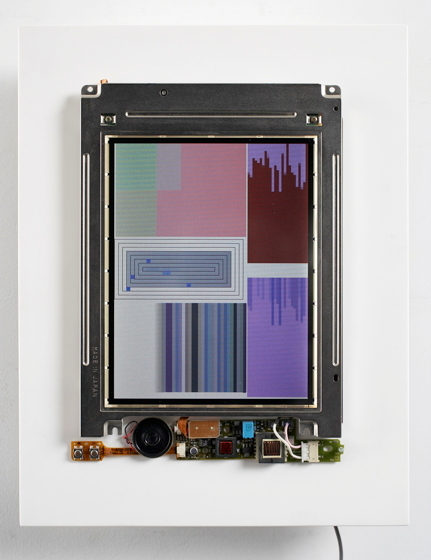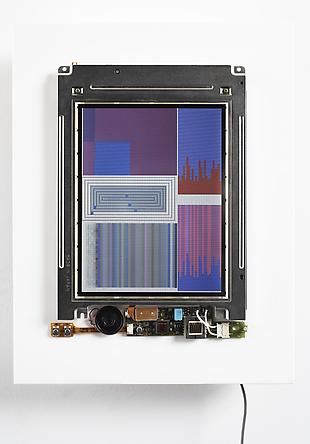Color Panel v1.0, 1999
Software, Macintosh 280c and Plastic Acrylic14.5 x 10.5 x 3.5 inchesRuns Continuously, Never RepeatsEdition of 12 |
|
Color Panel v 1.0 is a time based color study. Influenced by the Bauhaus movement, Color Panel interprets color ‘rules’ into software. The software iterates through color possibilities explored in theories proposed by Bauhaus artists including Klee and Kandinsky. The activation of these studies results in a dynamic composition of changing color pallets that never repeat. |
|
2018: |
Programmed: Rules, Codes, and Choreographies in Art, 1965 - 2018, Whitney Museum of American Art, NYC
|
2016: |
Tech-né-Color, Sandra Gering Inc, NYC
|
2015: |
Technologism, Monash University Museum of Art | MUMA, Australia
| ,
2012: |
Digital Paintings, Louisiana Art & Science Museum, Baton Rouge, LA
|
2005: |
Techno/Sublime, CU Art Museum, University of Colorado, Boulder, CO |
2004: |
Seeing Double: Emulations in Theory and Practice, Solomon R. Guggenheim Museum, New York |
2002: |
John F. Simon, Jr.,SITE Santa Fe, Santa Fe, NM |
2001: |
TranspolyBlu, Elliot Smith Contemporary Art, St. Louis, MO |
2000: |
An Art of Pure Form: works from the collection of the Solomon R. Guggenheim Museum, New York State Museum, Albany, NY |
1999: |
Cyber Cypher Either End, Mario Diacono Gallery, Boston, MA |
Whitney museum audio guideColor Panel v1.0 was made in 1999. I took a used Apple 280C computer. Disassembled it. Took it all to pieces. Took the case off of it, and then I reassembled it so that the screen was on the front of the panel, and the body of the computer was on the back. I turned the screen vertically instead of horizontally, which it usually was. And then I wrote a piece of software, custom, for that display. That was my canvas, so I want to make a time-based color study. I want to make a painting that would change continually and never repeat itself. It was an experiment in dynamic painting. It's hard to describe how little display power and computing power there was on that computer. Even the simplest electronic device today has more power than that computer did, so I was limited in what I could do. I had a software method that I called variable expansion, so I make a simple rule, and I get that running, and it's in a small loop, which is like a paragraph in code writing. So I have a little loop that's running. Then I begin to improvise with the loop by taking the parts that are set, and turning them into variables, expanding their range, and seeing what happens. So in the lower left hand corner of the Color Panel I had squares of different colors bouncing back and forth in a rectangle. So there were lots of choices what to do then. Do they overlap? Did they grow? Did they shrink? How do they mix? That kind of thing. |
|

